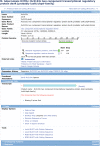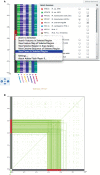TB database: an integrated platform for tuberculosis research
- PMID: 18835847
- PMCID: PMC2686437
- DOI: 10.1093/nar/gkn652
TB database: an integrated platform for tuberculosis research
Abstract
The effective control of tuberculosis (TB) has been thwarted by the need for prolonged, complex and potentially toxic drug regimens, by reliance on an inefficient vaccine and by the absence of biomarkers of clinical status. The promise of the genomics era for TB control is substantial, but has been hindered by the lack of a central repository that collects and integrates genomic and experimental data about this organism in a way that can be readily accessed and analyzed. The Tuberculosis Database (TBDB) is an integrated database providing access to TB genomic data and resources, relevant to the discovery and development of TB drugs, vaccines and biomarkers. The current release of TBDB houses genome sequence data and annotations for 28 different Mycobacterium tuberculosis strains and related bacteria. TBDB stores pre- and post-publication gene-expression data from M. tuberculosis and its close relatives. TBDB currently hosts data for nearly 1500 public tuberculosis microarrays and 260 arrays for Streptomyces. In addition, TBDB provides access to a suite of comparative genomics and microarray analysis software. By bringing together M. tuberculosis genome annotation and gene-expression data with a suite of analysis tools, TBDB (http://www.tbdb.org/) provides a unique discovery platform for TB research.
Figures





References
-
- Corbett EL, Watt CJ, Walker N, Maher D, Williams BG, Raviglione MC, Dye C. The growing burden of tuberculosis: global trends and interactions with the HIV epidemic. Arch. Intern. Med. 2003;163:1009–1021. - PubMed
-
- Gandhi NR, Moll A, Sturm AW, Pawinski R, Govender T, Lalloo U, Zeller K, Andrews J, Friedland G. Extensively drug-resistant tuberculosis as a cause of death in patients co-infected with tuberculosis and HIV in a rural area of South Africa. Lancet. 2006;368:1575–1580. - PubMed
Publication types
MeSH terms
LinkOut - more resources
Full Text Sources
Medical

